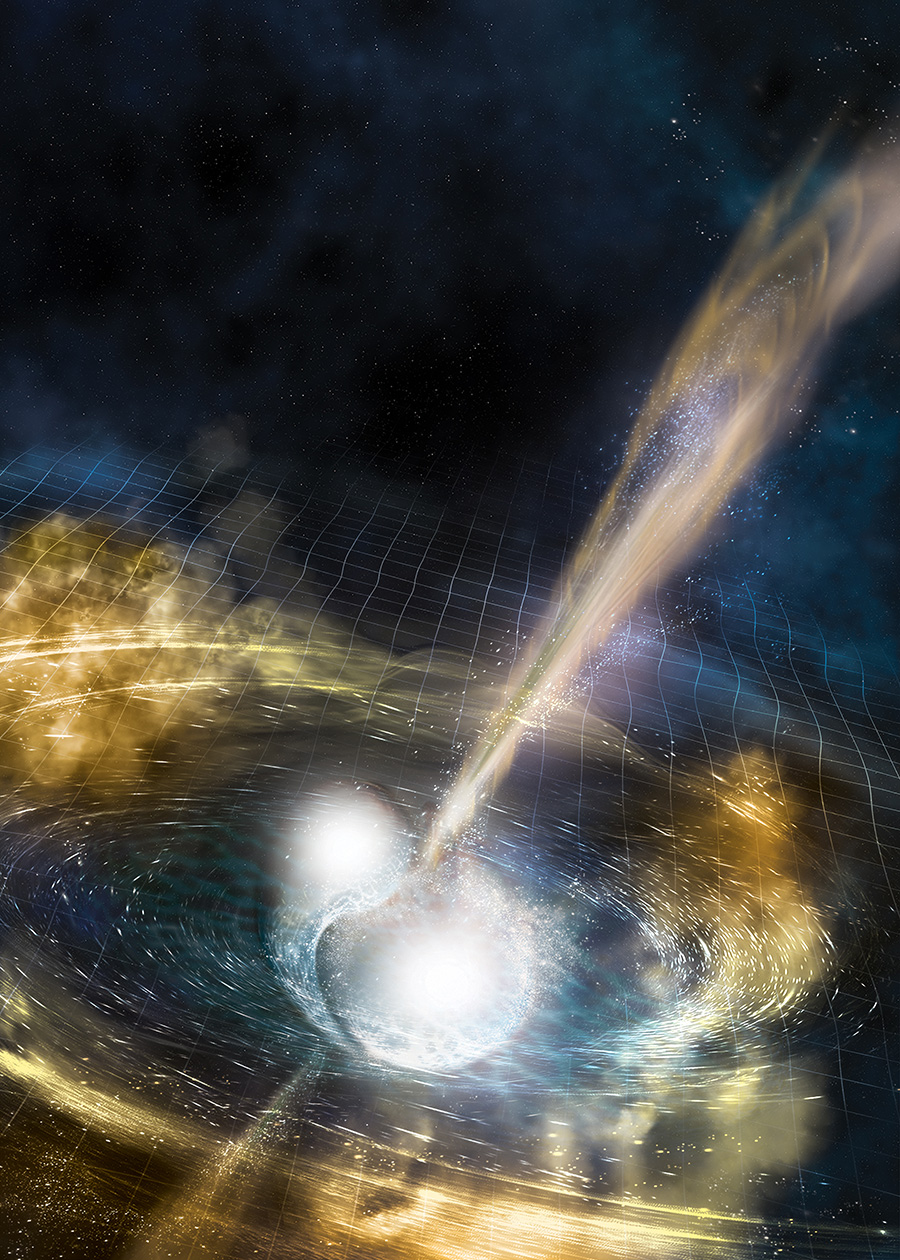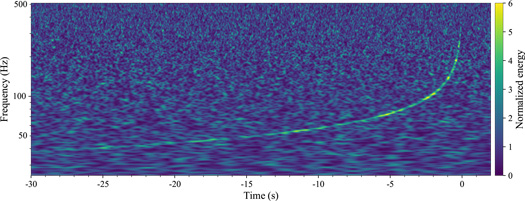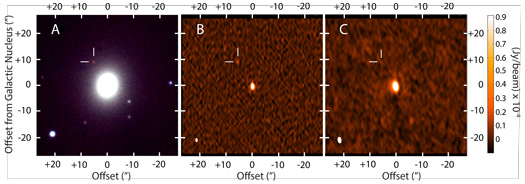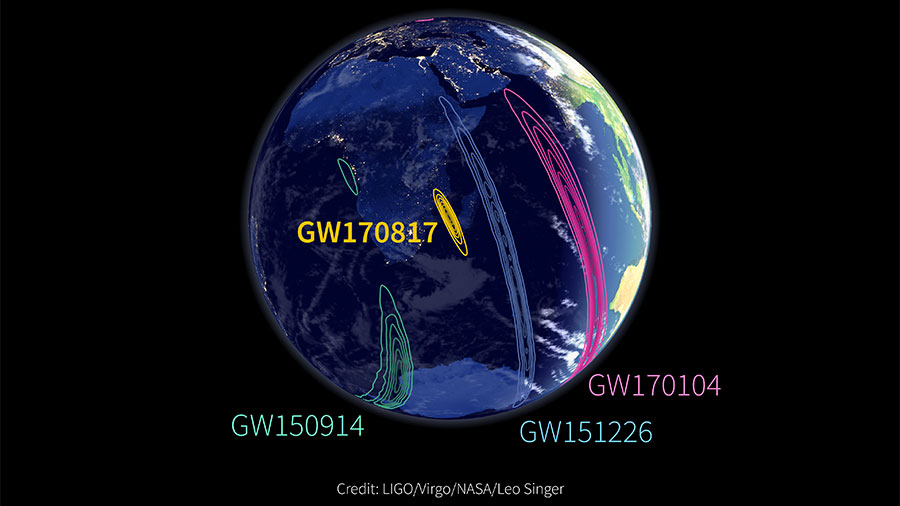New Finding by LIGO Scientists Could Change the Way We Do Astronomy
By: Glenys Young
Less than two weeks after the founders of the Laser Interferometer Gravitational-Wave Observatory (LIGO) were awarded the Nobel Prize in Physics for the detection of gravitational waves, LIGO scientists, including Texas Tech University's own Alessandra Corsi and Benjamin Owen, are announcing another major scientific breakthrough.
On Aug. 17, LIGO and Virgo, its European counterpart, detected gravitational waves from the merger of two neutron stars 130 million light years away, an event dubbed GW170817. A mere 1.7 seconds later, the NASA/Fermi satellite recorded a flash of gamma rays, but scientists immediately noticed the rays were substantially less bright than all the gamma rays they'd previously seen.

Hours later, the merger was detected in ultraviolet, visible and infrared light. X-rays showed up nine days later, and on the 16th day, Corsi's team finally detected a radio signal from the event using the Karl G. Jansky Very Large Array (VLA) at the National Radio Astronomy Observatory, a facility of the National Science Foundation (NSF) operated under cooperative agreement by Associated Universities Inc.
Those radio and X-ray observations became key to deciphering the mystery of the too-dim gamma rays.
The Merger
Neutron stars are different from regular stars. When large stars explode and collapse in on themselves – a phenomenon called a supernova – what remains is the star's small, ultra-dense core. The electrons and protons found in normal matter melt into one another, forming neutrons – hence the name.
When two neutron stars approach one another, spiraling in toward their eventual merger, they send off gravitational waves. It had been hypothesized that after the neutron stars collide, a jet of fast-moving material is emitted at high latitudes, where gamma rays are produced in a phenomenon known as short gamma-ray burst. As this jet gradually decelerates and expands, X-rays and radio waves – with a very high frequency, far above what humans can hear – are also emitted in a phenomenon called afterglow. The Fermi satellite detection of gamma rays only 1.7 seconds after the LIGO detection represents the first direct proof that short gamma-ray bursts originate from binary neutron star mergers.
“We thought it would be years before we could do it, but this one was so loud we actually got information on the structure of the neutron stars,” said Owen, a professor in the Texas Tech Department of Physics & Astronomy. “Roughly speaking, we could tell the radius as well as the mass, and that tells us about matter under extreme conditions. Neutron stars are the densest matter in the universe and it's uncertain how that stuff behaves.”
Every previous observation of gamma-ray bursts has involved a jet pointing from the source to Earth. Because in this event it took the X-rays and radio waves so much longer to reach Earth than the gamma rays and visible light, scientists now believe they are seeing the gamma ray burst from the side.
“This is the first time a gamma-ray burst has been seen whose jet wasn't directly pointed at Earth,” said Corsi, an assistant professor at Texas Tech. “We think that when this merger took place, we weren't lucky enough to sit exactly on the axis of the fast jet. Radio tells us we observed the light from the neutron star merger but we saw it differently from before, when we had this really privileged viewpoint of gamma-ray bursts.
“If Earth was aligned with the jet, we would have seen the radio emission earlier and brighter. Because of the delayed onset in the radio, we can tell we're observing off-axis. Off-axis gamma ray bursts are something people have hunted for about 20 years and never found. LIGO and Virgo just gave us the first opportunity to image in radio an off-axis jet.”
Because seeing neutron star binary mergers from an off-axis perspective is far more likely than having them point directly at Earth, scientists can now use radio waves to study the emission from events like GW170817 instead of waiting for a direct hit from a gamma-ray burst. Observations of off-axis bursts offer a unique opportunity to probe how fast jets produced in neutron star mergers drill through the tidally ejected material and how they later interact with the interstellar medium – the matter between stars.
“Now we expect that, next time LIGO sees a merger between two neutron stars, we can use radio telescopes to see the merger, no matter how it's oriented,” Corsi said. “Radio emission is ubiquitous.”
GW170817 also is the first time any astronomical event has been observed in both gravitational waves and in light. It's important to study astronomical events through as many messengers as possible to get the most accurate and complete understanding of it.
“There's a fundamental difference between optical-infrared emission and X-rays and radio,” Corsi said. “The emission in optical and infrared probes the neutron-rich ejecta and how heavy elements are being formed – in this merger, you get elements heavier than iron forming via a series of nuclear reactions so we can explain how gold, platinum, etc. are created. The radio and X-rays probe a different type of emission and provide complementary information, such as how much energy is coupled to the fastest ejecta, and in fact they tell us that there is a fast (relativistic) component.
“There are things you cannot probe with only one of these messengers. You cannot tell about strong gravity without gravitational waves; you cannot tell what's around the merger and what happened to the material spit out in all directions without the light; you cannot say what elements were synthesized without the light. It's just through putting things together that you can arrive at a picture to really understand what happens during the catastrophic cosmic collision of two neutron stars.”
The findings achieved from this binary neutron star merger are likely to have far-reaching effects throughout the entire field.
“This is really going to change the way we do astronomy,” Corsi said.
“It's just a harbinger of things to come,” Owen agreed. “If you ask about the scale or history of the universe, one merger doesn't tell us that much. But as we get more in the coming years, we can do demographics and really say something.”

Radio
Texas Tech played a leading role in the detection of the radio signal that has been so instrumental in this event.
Corsi is the principal investigator of an observing program on the VLA through which the first images of the radio counterpart to the gravitational wave event were collected. Her work is funded by a National Science Foundation (NSF) CAREER Award specifically geared toward joining gravitational wave and radio observations.
After the gravitational waves and gamma rays were detected, a bright optical transient consistent with the sky location of the gravitational waves was identified by the Swope telescope at Carnegie Observatories' Las Campanas Observatory in Chile. The optical counterpart was also detected by several other teams, including the Distance Less Than 40 Mpc survey, led by David Sand of the University of Arizona, a collaborator of Corsi and former Texas Tech colleague.
Corsi and her team triggered their VLA program in response to the optical detection, in hopes of finding a radio counterpart.
“From that day, the thing I remember most clearly is a message from Dale Frail of the National Radio Astronomy Observatory, a co-investigator on my VLA observing program and a long-term collaborator, saying, ‘You better be ready' with a smiley face at the end. That was just so exciting!” Corsi said.
“After the initial excitement, it took a lot of patience to finally arrive to the discovery of a radio glow. In fact, the radio turned on only 16 days after the LIGO-Virgo alert. And initially it was such a faint radio glow that only the VLA could have detected it. I was fortunate to be leading one of the two groups who discovered the radio independently. Gregg Hallinan of the California Institute of Technology (Caltech) also independently detected the radio signal in images taken with the VLA on the same day but at a different frequency. When we compared our findings, we knew that was it: we had discovered the first radio counterpart to gravitational waves from the collision of two neutron stars.”
Texas Tech is also a member of a larger team of astronomers and physicists, called the Global Relay of Observatories Watching Transients Happen (GROWTH), who joined forces right after the LIGO alert to hunt for light from the cosmic smashup.
“Being part of GROWTH was particularly useful because it put me in contact with our colleagues who used the Australia Telescope Compact Array to confirm the radio detection a few days after my team had announced it,” Corsi said.
The results of this effort appear today in an article published in the journal Science (Hallinan, Corsi et al. DOI 10.1126/science.aap9855).

(A) Near-infrared image taken on Aug. 27.
(B) Radio image of the same field created using VLA observations on Sept. 9.
(C) A combined image from four VLA operations spanning Aug. 22 to Sept. 1.
Credit: Hallinan, Corsi, et al. Science, DOI 10.1126/science.aap9855
Gravitational Waves
Owen's work on this discovery focused primarily on studying the structures of the neutron stars through the tidal effects on gravitational waves produced in the merger.
The original gravitational wave detection from two merging black holes, an event dubbed GW150914, verified Albert Einstein's prediction from his 1916 General Theory of Relativity. This neutron star merger gave scientists another opportunity to test the theory.
“Relativity predicts that gravitational waves travel at the speed of light,” Owen said, “and you can test if that's right.
The gravitational waves and the gamma rays arrived at Earth only 1.7 seconds apart after travelling 130 million light years.
“This puts a really tight constraint on it,” Owen said. “If there's some deviation from the speed of light, that deviation has to be really small.

“Relativity does seem to be right, as far as we can tell.”
The General Theory of Relativity is not the only scientific principle that gravitational waves are helping to solidify. Scientists have worked for generations to pinpoint the Hubble Constant, the unit of measurement used to describe the expansion of the universe.
“The way astronomers determine the size of the universe, and its age and history, is by looking at the Hubble Constant,” Owen said. “For decades, there's been this discrepancy between two different ways of measuring it. They've been gradually converging, but it's really hard trying to figure out the Hubble Constant just from the light; there are a lot of things that get in the way and complicated systematic errors. One thing that has come out just from the gravitational waves is a measurement of the distance and the Hubble Constant that is independent of light. With one merger, the error bars are too big to resolve the discrepancy, but with more mergers the error bars will get smaller and won't be contaminated by the systematics you get with light.”
At the time of the discovery, the Texas Tech LIGO team also included postdoctoral researchers Santiago Caride, Rob Coyne, Ra Inta and Nipuni Palliyaguru and graduate students Binod Rajbhandari and Eric Sowell. The LIGO Science Collaboration and Virgo Collaboration consist of a thousand scientists and engineers at dozens of universities around the world.
LIGO is funded by the NSF, and operated by Caltech and the Massachusetts Institute of Technology, which conceived of LIGO and led the Initial and Advanced LIGO projects. Financial support for the Advanced LIGO project was led by the NSF with Germany (Max Planck Society), the U.K. (Science and Technology Facilities Council) and Australia (Australian Research Council) making significant commitments and contributions to the project. More than 1,200 scientists and some 100 institutions from around the world participate in the effort through the LIGO Scientific Collaboration, which includes the GEO Collaboration and the Australian collaboration OzGrav. Additional partners are listed at http://ligo.org/partners.php.
The Virgo collaboration consists of more than 280 physicists and engineers belonging to 20 different European research groups: six from Centre National de la Recherche Scientifique (CNRS) in France; eight from the Istituto Nazionale di Fisica Nucleare (INFN) in Italy; two in the Netherlands with Nikhef; the MTA Wigner RCP in Hungary; the POLGRAW group in Poland; Spain with the University of Valencia; and the European Gravitational Observatory, EGO, the laboratory hosting the Virgo detector near Pisa in Italy, funded by CNRS, INFN and Nikhef.
Discoveries
-
Address
Texas Tech University, 2500 Broadway, Box 41075 Lubbock, TX 79409 -
Phone
806.742.3905 -
Email
vpr.communications@ttu.edu
